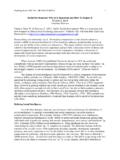Transcription of Developmental Psychology: Theories of Development- Part I
1 Developmental Psychology: Theories of development - Part I. Dr. Meenakshi Shukla Assistant Professor, Department of Psychology, Magadh University, Bodh Gaya The Psychoanalytic Perspective According to the psychoanalytic perspective, children move through a series of stages in which they confront conflicts between biological drives and social expectations. How these conflicts are resolved determines the person's ability to learn, to get along with others, and to cope with anxiety. Among the many individuals who contributed to the psychoanalytic perspective, two were especially influential: Sigmund Freud, founder of the psychoanalytic movement, and Erik Erikson.
2 Freud's Theory Freud (1856 1939), a Viennese physician, sought a cure for emotionally troubled adults by having them talk freely about painful events of their childhoods. Working with these recollections, Freud examined the unconscious motivations of his patients and constructed his psychosexual theory, which emphasizes that how parents manage their child's sexual and aggressive drives in the first few years is crucial for healthy personality development . In Freud's theory, three parts of the personality id, ego, and superego become integrated during a sequence of five stages.
3 The id , the largest portion of the mind, is the source of basic biological needs and desires. The ego , the conscious, rational part of personality, emerges in early infancy to redirect the id's impulses so they are discharged in acceptable ways. Between 3 and 6 years of age, the superego , or conscience, develops through interactions with parents, who insist that children conform to the values of society. Now the ego faces the increasingly complex task of reconciling the demands of the id, the external world, and conscience (Freud, 1923/1974). For example, when the id impulse to grab an attractive toy from a playmate confronts the superego's warning that such behavior is wrong, the ego must mediate between these two forces, deciding which will win the inner struggle or, alternatively, working out a compromise, such as asking for a turn with the toy.
4 According to Freud, the relations established among id, ego, and superego during the preschool years determine the individual's basic personality. Freud (1938/1973) believed that during childhood, sexual impulses shift their focus from the oral to the anal to the genital regions of the body. In each stage, parents walk a fine line between permitting too much or too little gratification of their child's basic needs. If parents strike an appropriate balance, then children grow into well-adjusted adults with the capacity for mature sexual behavior and investment in family life.
5 Freud's theory was the first to stress the influence of the early parent child relationship on development . an emphasis that continues to play a role in many contemporary Theories . But his perspective was eventually criticized. First, it overemphasized the influence of sexual feelings in development . Second, because it was based on the problems of sexually repressed, well-to-do adults in nineteenth-century Victorian society, it did not apply in other cultures. Finally, Freud had not studied children directly. Erikson's Theory Several of Freud's followers took what was useful from his theory and improved on his vision.
6 The most important of these neo-Freudians is Erik Erikson (1902 1994), who expanded the picture of development at each stage. In his psychosocial theory, Erikson emphasized that in addition to mediating between id impulses and superego demands, the ego makes a positive contribution to development , acquiring attitudes and skills that make the individual an active, contributing member of society. A basic psychosocial conflict, which is resolved along a continuum from positive to negative, determines healthy or maladaptive outcomes at each stage. Erikson's first five stages parallel Freud's stages, but Erikson added three adult stages.
7 He was one of the first to recognize the lifespan nature of development . Unlike Freud, Erikson pointed out that normal development must be understood in relation to each culture's life situation. For example, in the 1940s, he observed that Yurok Indians of the northwest coast deprived babies of breastfeeding for the first 10 days after birth and instead fed them a thin soup. At age 6 months, infants were abruptly weaned if necessary, by having the mother leave for a few days. From our cultural vantage point, these practices may seem cruel. But Erikson explained that because the Yurok depended on salmon, which fill the river just once a year, the development of considerable self-restraint was essential for survival.
8 In this way, he showed that child rearing is responsive to the competencies valued and needed by the child's society. Contributions and Limitations of the Psychoanalytic Perspective A special strength of the psychoanalytic perspective is its emphasis on the individual's unique life history as worthy of study and understanding. Consistent with this view, psychoanalytic theorists accept the clinical, or case study method, which synthesizes information from a variety of sources into a detailed picture of the personality of a single child. Psychoanalytic theory has also inspired a wealth of research on many aspects of emotional and social development , including infant caregiver attachment, aggression, sibling relationships, child-rearing practices, morality, gender roles, and adolescent identity.
9 Despite its extensive contributions, the psychoanalytic perspective is no longer in the mainstream of child development research. Psychoanalytic theorists may have become isolated from the rest of the field because they were so strongly committed to in-depth study of individual children that they failed to consider other methods. In addition, many psychoanalytic ideas, such as psychosexual stages and ego functioning, are too vague to be tested empirically (Crain, 2005; Thomas, 2005). Nevertheless, Erikson's broad outline of psychosocial change captures the essence of psychosocial attainments at each age period.
10 Behaviourism and Social Learning Theory As the psychoanalytic perspective gained in prominence, child study was also influenced by a very different perspective. According to behaviourism, directly observable events stimuli and responses are the appropriate focus of study . North American behaviourism began in the early twentieth century with the work of psychologist John Watson (1878 1958), who wanted to create an objective science of psychology. Traditional Behaviourism: Watson was inspired by Russian physiologist Ivan Pavlov's studies of animal learning.










